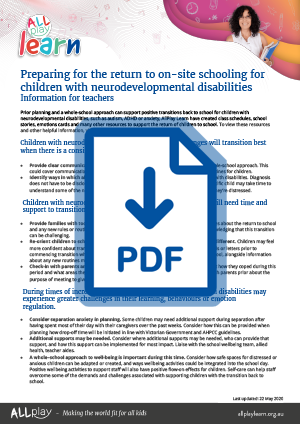
Preparing for return
to on-site learning
On this page:
- Consistent whole-school approach
- Support transitioning back to school
- Support with learning, behaviours and emotion regulation
Some children may need time and support to transition back to on-site learning. Some children who may particularly benefit from preparation and planning for their return include children with autism, ADHD, anxiety, intellectual disabilities, or children with additional learning needs, as well as any children who are known to find transitions challenging. Teachers may consider the following strategies to support children with positive transitions.

Children will transition best when there is a consistent whole-school approach.
- Provide clear communication and support to staff in order to create a consistent whole-school approach. This could cover communication about COVID-19, and consistency around new rules and routines for children.
- Identify ways in which all staff can provide a positive transition to specific children. Diagnosis does not have to be disclosed to all staff. Instead, this can be as simple as noting if a specific child may take time to understand some of the new rules, or providing strategies to use with a specific child if they’re distressed.

Children will need time and support to transition back to school.
- Provide families with tools for the transition. Create visual schedules and social stories about the return to school and any new rules or routines that children will learn. Use positive language while acknowledging that this transition can be challenging. You may also like to share AllPlay Learn's Families pages to help children prepare for the transition at home.
- Re-orient children to school; highlight what has stayed the same and what will be different. Children may feel more confident about transitioning back to school when they know what to expect. Emails or letters prior to commencing transition which include photos of familiar faces and places around the school, alongside information about any new routines may also help with the transition.
- Check-in with parents and the child. Take time to speak to parents and the child about how they coped during this period and what areas they may need support in during the transition. Communicate with families prior to calling about the purpose of the call to give them time to prepare too. AllPlay Learn’s teacher's guide to parent-teacher meetings may be a good starting point for these discussions.

During times of increased anxiety and change, some children may experience greater challenges in their learning, behaviours or emotion regulation.
- Consider separation anxiety in planning. Some children may need additional support during separation after having spent most of their day with their caregivers over the past weeks. Consider how this can be provided when planning how drop-off time will be initiated in line with Victorian Government and AHPCC guidelines.
- Additional supports may be needed. Consider where additional supports may be needed, who can provide that support, and how this support can be implemented for most impact. Liaise with the school wellbeing team, allied health, teacher aides. The AllPlay Learn behaviour support page may be helpful.
- A whole–school approach to well-being is important during this time. Consider how safe spaces for distressed or anxious children can be adapted or created, and ways wellbeing activities could be integrated into the school day. Positive wellbeing activities to support staff will also have positive flow-on effects for children. Self-care can help staff overcome some of the demands and challenges associated with supporting children with the transition back to school back to school.

